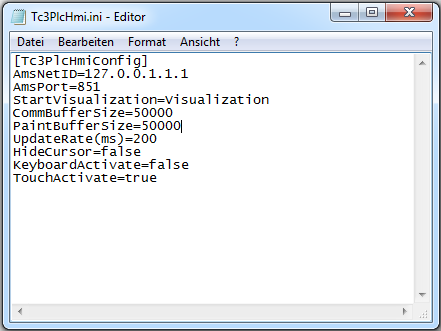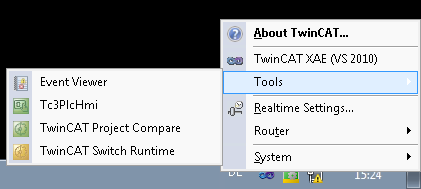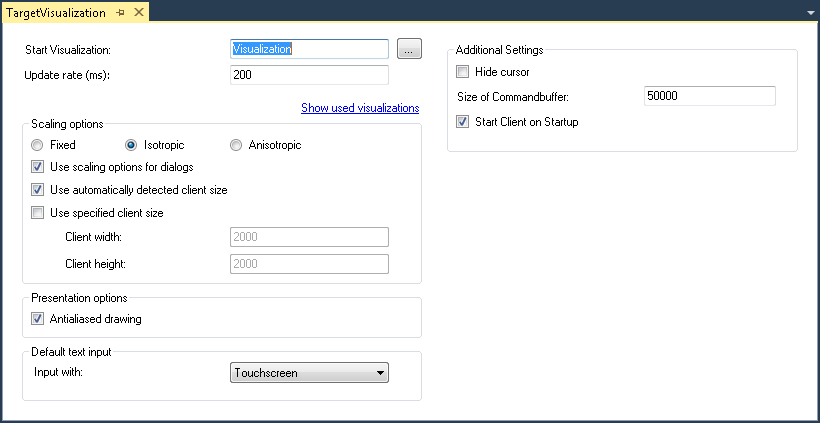PLC HMI
The PLC HMI is an extension of the runtime system and enables the visualization to be executed on the control computer or a third computer without a development environment. The visualization code is created based on the existing visualization objects and downloaded to the control computer. Avoiding the use of the development environment results in significant memory savings. This can be useful for small computers.
The following topics are described below:
- Commissioning the PLC HMI
- Remote operation of a PLC HMI Client
- Editor of the TargetVisualization object
Commissioning the PLC HMI
Step 1: Enable the PLC HMI
The object "TargetVisualization" ( ) enables the PLC HMI. It can be added to the object "Visualization Manager" in the PLC project tree via the context menu command Add > TargetVisualization (see also PLC documentation: Creating a visualization > Visualization object).
) enables the PLC HMI. It can be added to the object "Visualization Manager" in the PLC project tree via the context menu command Add > TargetVisualization (see also PLC documentation: Creating a visualization > Visualization object).
With the TargetVisualization object a visualization task "VISU_TASK" is created in the Solution and a reference to this task in the PLC project. The reference is used to call the visualization code. Therefore, you have to reactivate the configuration after adding the object.
 | Deleting a TargetVisualization object If you delete a TargetVisualization object and have not added an additional WebVisualization object, you have to delete the task "VISU_TASK" under System > Tasks in the TwinCAT project tree. This task is not required in the integrated visualization. (See also Editor of the object WebVisualization and Integrated visualization) |
Step 2: Configure the PLC HMI Client
 | Step 2 is only necessary if you are using a Build <4022.0 or if you want to start a PLC HMI Client with a remote connection to the runtime device. From Build 4022.0 or higher, the .ini file is automatically generated and updated in the folder C:\TwinCAT\3.1\Boot\Plc. From Build 4026.0 or higher, the .ini file is automatically generated and updated in the folder C:\ProgramData\Beckhoff\TwinCAT\3.1\Boot\Plc. |
In order to establish the connection between the client and the device on which the corresponding visualization code is executed, you must adapt the Tc3PlcHmi.ini file.
The .ini file is available for Builds <4022.0 in the folder C:\TwinCAT\3.1\Components\Plc\Tc3PlcHmi, for Builds >=4022.0 in the folder C:\TwinCAT\3.1\Boot\Plc and for Builds >=4026.0 in the folder C:\ProgramData\Beckhoff\TwinCAT\3.1\Boot\Plc
Example of a .ini file:

AMSNETID | AmsNetID of the device, on which the visualization code is executed. Preset: 127.0.0.1.1.1 |
AmsPort | AmsPort of PLC project, to which the visualization belongs. Preset: 851 |
StartVisualization | Name of the visualization object to be opened as start page. Preset: Visualization |
CommBufferSize | Memory size in bytes that the visualization allocates for this PLC HMI Client and uses for the communication. Preset: 50000 |
PaintBufferSize | Memory size in bytes that the visualization allocates for this PLC HMI Client and uses for the drawing actions. Preset: 50000 |
UpdateRate(ms) | Update rate in milliseconds, at which the client data are queried again. Preset: 200 |
HideCursor | Setting through which the cursor can be hidden. Preset: false |
KeyboardActivate | Setting through which input via a hardware keyboard is enabled. A software keyboard is used automatically if this setting is disabled. Preset: false |
TouchActivate | Setting through which touch-based input is enabled. Preset: true |
Step 3: Set PLC HMI as startup application
 | Step 3 is only necessary if you are using a Build <4024.0 or if you want to start a PLC HMI Client with a remote connection to the runtime device. From Build 4024 or higher, the PLC HMI Client is automatically started locally on the runtime device. |
If PLC HMI is to start automatically when the computer is booted with the boot project, there must be a link to the Tc3PlcHmi.exe application in the StartUp folder.
Execute the following steps to do this:
- Open the directory C:\TwinCAT\3.1\Target\StartUp.
- Add a new link via the context menu command New.
- Enter C:\TwinCAT\3.1\Components\Plc\Tc3PlcHmi\Tc3PlcHmi.exe as storage location.
- Confirm this dialog and the following dialog.
Execute the following steps for Beckhoff CE devices:
- Start the Beckhoff Startup Manager under Start > StartMan.
- Add a new item via the New button.
- Give the item the name "Tc3PlcHmi" and select the type "ShellCommand".
- Confirm the dialog.
- Under the Startup Options, select "Autostart" and enter a time under Delay in order to open the client only when the PLC project has already been started.
- Switch to the Shell Command tab.
- In the field Enter Shell command, enter "\Hard Disk\TwinCAT\3.1\Components\Plc\Tc3PlcHmi\X.exe". Replace the "X" with the name of the Client Exe that is stored under the specified path. This may differ between ARM and ATOM devices, for example.
- Confirm the dialog.
Step 4: Start the PLC HMI Client
 | Step 4 is only necessary if you are using a Build <4024.0 or if you want to start a PLC HMI Client with a remote connection to the runtime device. From build 4024 or higher, the PLC HMI Client is automatically started locally on the runtime device. |
A PLC HMI Client is started with the aid of the Tc3PlcHmi.exe application. This is located in the directory C:\TwinCAT\3.1\Components\Plc\Tc3PlcHmi, but can also be linked to any desired location. If you create a link in the directory C:\TwinCAT\3.1\Target\StartMenuAdmin\Tools you can start the application via the TwinCAT icon in the context menu under Tools.

If the development PC is connected, the visualization can also be displayed in the development environment. However, it is not equivalent to an integrated visualization, but is also based on a PLC HMI Client.
For Beckhoff CE devices you have to activate a setting in the visualization manager before starting the client; this setting enables all image files in the svg format to be automatically converted to the bmp format. This step is required, because under CE only image files in bmp format are supported in the PLC HMI Client. Both image file formats are nevertheless loaded on the target system, since a PLC HMI Web Client continues to use the svg format. The PLC HMI Client for CE can be found in directory \Hard Disk\TwinCAT\3.1\Components\Plc\Tc3PlcHmi.
See also:
- PLC documentation: Creating a visualization > Visualization Manager > Settings
- PLC documentation: Creating a visualization > Visualization variants > Integrated visualization
- Documentation TC3 PLC HMI Web
Remote operation of a PLC HMI Client
A PLC HMI Client can also be operated remotely on a third computer, which is neither the development computer nor the control computer. To do this, the following requirements must be met:
- A TwinCAT 3 Build 4018.0 ADS or later is installed on the system.
- ADS communication is established with the control computer on which the visualization code is executed (TwinCAT Icon > Router > Edit Routes > Add…).
- The Tc3PlcHmi folder has been copied from the development or control computer to the third system. The path for the folder must be added manually.
- The Tc3PlcHmi.ini file was adjusted on the system, on which the client is to run.
Editor of the TargetVisualization object
The "TargetVisualization" object ( ), which you can add in the PLC project tree below the "Visualization Manager" object, enables the PLC HMI and contains its settings. Double-click on the object in order to edit the settings in an editor window.
), which you can add in the PLC project tree below the "Visualization Manager" object, enables the PLC HMI and contains its settings. Double-click on the object in order to edit the settings in an editor window.
 | The settings in the object "TargetVisualization" are adopted automatically into the .ini file from build 4022.0 onwards. If you wish to use an older build or start a PLC HMI Client with a remote connection to the runtime device, you have to make the changes to the settings in the .ini file manually. |

Start visualization | Name of the visualization object that is to be opened as the first page when starting the PLC HMI. A visualization object is already entered here by default. The input assistant can be used to select a different visualization object. If the PLC project contains only one visualization object, this is automatically used as start visualization. |
Update rate (ms) | The update rate in milliseconds, with which the data in the PLC HMI is updated. |
Show used Visualizations | Button for opening the standard dialog of the Visualization Manager: Here you can select the visualizations that are to be used for the PLC HMI. (See also PLC documentation: Creating a visualization > Visualization Manager > Visualizations) |
Scaling options
Fixed | The size of the visualization is retained, irrespective of the screen size. |
Isotropic | The size of the visualization depends on the size of the screen. The visualization retains its proportions. |
Anisotropic | The size of the visualization depends on the size of the screen. The visualization does not retain its proportions. |
Using scaling options for dialogs | The dialogs, also keypad and numpad, are scaled with the same scaling factor as the visualization. This is advantageous if a dialog was created to match the visualization. |
Use automatically determined client size | The PLC HMI fills the client screen. |
Use specified client size | The PLC HMI fills the screen area determined by the following dimensions.
|
Presentation options
Characters with antialiasing | Activate this option, if antialiasing is to be used when the visualizations are drawn in the visualization editor window of the programming system. (Offline or online) |
Standard text input
This setting is only then active if the input type “Standard” is selected in the input configuration of the visualization element. In this case, the default text entries defined in the Visualization Manager are used.
Touchscreen | Select this option if the target device is operated with a touch screen by default. |
Keyboard | Select this option if the target device is operated with a keyboard by default. |
Advanced Settings
Hide mouse pointer | Setting through which the cursor can be hidden. |
Size of the command buffer | Memory size in bytes that the visualization allocates for this PLC HMI Client and uses for the communication. |
Start client on startup | The PLC HMI client is automatically started locally on the runtime system. |